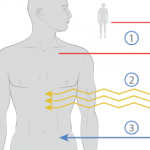
Stem cells in a fluid are being transferred for study.
CI Photos/shutterstock.com
Rheumatologists now have another treatment option to offer their patients with one of, if not the most, difficult autoimmune diseases to treat. New data add to the growing evidence of the safety and benefit of stem cell transplantation for patients with systemic sclerosis with internal organ involvement.
New results of the Scleroderma: Cyclophosphamide or Transplantation (SCOT) trial show that patients with systemic sclerosis with lung involvement who underwent myeloablative autologous hematopoietic stem cell transplantation (HSCT) had superior long-term outcomes compared with patients treated with monthly intravenous cyclophosphamide (CYC).
Reporting on the results of the trial at the 2016 ACR/ARHP Annual Meeting, Keith Sullivan, MD, James B. Wyngaarden Professor of Medicine in the Division of Cellular Therapy, Duke University Medical Center, Durham, N.C., says the results suggest it’s time to consider this treatment approach for select patients with systemic sclerosis with early, severe internal organ involvement.1
“Our job is to fully inform the patient and caregiver of the results of randomized clinical trials and the usefulness of the procedure,” he says, emphasizing that rheumatologists now have a treatment option for this difficult and often fatal disease that patients should know about.
“I’m not trying to oversell this,” he says, “I am trying to have colleagues see things through patients’ eyes, because if the patient never gets referred for a consultation with a transplant physician, this treatment will never be an option for them.”
What the Data Show
Results of the multicenter SCOT trial (currently in peer review for publication) support and expand the evidence for the superiority of stem cell transplantation compared with pulse CYC for select patients with systemic sclerosis, previously reported in the Autologous Stem Cell Transplantation International Scleroderma (ASTIS) trial, and to a more limited degree (because of shorter follow-up of a smaller patient cohort), in the American Scleroderma Stem Cell vs. Immune Suppression Trial (ASSIST).2
In the SCOT trial (sponsored by the National Institutes of Health, National Institute of Allergy and Infectious Diseases), 75 patients with diffuse cutaneous systemic sclerosis and progressive lung or renal involvement were randomized to CYC (750 mg/m2/month) infused over one year (n=39) or myeloablative HSCT (n=36). Unlike the ASTIS and ASSIST trials in which patients were given nonmyeloablative high-dose CYC for both preparative conditioning and stem cell mobilization, the SCOT trial used a lower dose of pre-transplant CYC and employed total body irradiation conditioning to eliminate all autoreactive immune cells prior to stem cell rescue.
To assess efficacy, the primary endpoint was a global rank composite score (GRCS) that ranked subjects based on a hierarchy of several important outcomes, including (in order) mortality, event-free survival (EFS) (without organ failure), lung function, scleroderma health assessment questionnaire and the modified Rodnan skin score.
At 54 months after randomization, the study found that in the intent-to-treat population, those undergoing stem cell transplantation had superior outcomes compared with the standard therapy group based on the GRCS. In the treated population, both overall survival and EFS were significantly improved after HSCT, supporting the primary finding. In addition, significantly fewer patients in the HSCT group had initiated disease-modifying anti-rheumatic drugs (DMARDs) at 54 months compared with the CYC group (9% vs 44%).
The study also found that serious adverse events were more frequent with HSCT and at 54 months. The overall mortality at 54 months was 9% in the HSCT arm compared with 24% in the CYC group. In the HSCT group, 3% of patients died of treatment-related causes. However, Dr. Sullivan emphasizes that the rates at study endpoint of treatment-related mortality and subsequent use of DMARDs were lower than those found in the ASTIS trial.
Talking to Patients
For Dr. Sullivan, these results strengthen the argument that practitioners should be talking to their patients about this treatment option. “Rheumatologists have two concerns,” he says: “Is this treatment approach safe, and are the improvements durable?” The results of the SCOT trial provide an affirmative answer to both, he says.
He advocates for rheumatologists to provide their patients with the needed information to make an informed decision by referring them to a center with expertise in the use of stem cell transplantation for scleroderma (see sidebar “Centers with Expertise in Scleroderma Research and Transplantation,” below).
Maureen D. Mayes, MD, professor of internal medicine, Elizabeth Bidgood Chair in Rheumatology, Division of Rheumatology and Clinical Immunogenetics, University of Texas McGovern Medical School, Houston, who works in one of these designated centers, emphasized the importance of speaking candidly to patients about the pros and cons of stem cell transplantation.
Acknowledging the positive results of the SCOT trial, she says stem cell transplantation is an option for patients with severe disease and a poor prognosis. However, she cautions that the positive results of the trial need to be balanced by the finding of a 3% treatment-related mortality.
This underscores the need to carefully select patients with a poor prognosis who are most likely to benefit from this treatment approach. “We’re looking at people with early diffuse skin disease who already have evidence of internal organ involvement,” she says.
Patients who Dr. Mayes thinks are good candidates are those with early disease within five years of disease onset, who declare themselves as having significant skin and internal organ disease, and who are not responsive to standard therapy. “If these patients have continuing disease involvement while on standard therapies, then it would be important to refer those patients to a center that is experienced with the high-dose chemotherapy and stem cell transplantation treatment approach,” she said.
Dr. Sullivan reinforces this message. “When a patient with scleroderma is referred for transplant consultation, the team will describe the procedure, risks and expected results,” adding that it is then in the hands of the patient, family and referring rheumatologist to determine the best option.
“It is shared decision making,” he says. “But if the patient never hears about the option from an experienced transplant team, they can’t make that informed decision.”
Mary Beth Nierengarten is a freelance medical journalist based in Minneapolis.
Centers with Expertise in Scleroderma Research & Transplantation
Reference
- Sullivan K, Keyes-Elstein L, McSweeney P, et al. Myeloablative autologous transplantation of CD34+ selected hematopoietic stem cells (HSCT) vs monthly intravenous cyclophosphamide (cyc) for severe scleroderma with internal organ involvement: Outcomes of a randomized North American clinical trial (abstract 6L). Arthritis Rheumatol. 2016 Oct 19;68(suppl 10).
- Sullivan KM, Shah A, Sarantopoulos S, Furst DE. Hematopoietic stem cell transplantation for scleroderma. Arthritis Rheumatol. 2016;68(10):2361–2371.

